Angela Ackerman's Blog: Writers Helping Writers, page 25
March 9, 2024
Character Type & Trope Thesaurus: Matriarch
In 1959, Carl Jung first popularized the idea of archetypes���”universal images that have existed since the remotest times.” He posited that every person is a blend of these 12 basic personalities. Ever since then, authors have been applying this idea to fictional characters, combining the different archetypes to come up with interesting new versions. The result is a sizable pool of character tropes that we see from one story to another.
Archetypes and tropes are popular storytelling elements because of their familiarity. Upon seeing them, readers know immediately who they’re dealing with and what role the nerd, dark lord, femme fatale, or monster hunter will play. As authors, we need to recognize the commonalities for each trope so we can write them in a recognizable way and create a rudimentary sketch for any character we want to create.
But when it comes to characters, no one wants just a sketch; we want a vibrant and striking cast full of color, depth, and contrast. Diving deeper into character creation is especially important when starting with tropes because the blessing of their familiarity is also a curse; without differentiation, the characters begin to look the same from story to story.
But no more. The Character Type and Trope Thesaurus allows you to outline the foundational elements of each trope while also exploring how to individualize them. In this way, you’ll be able to use historically tried-and-true character types to create a cast for your story that is anything but traditional.

DESCRIPTION: A female elder who rules over her family, tribe, or clan.
FICTIONAL EXAMPLES: Catelyn Stark (A Song of Ice and Fire), Lady Jessica (Dune), Mother Abagail (The Stand), Madea Simmons (the Madea franchise), Abuela Alma (Encanto)
COMMON STRENGTHS: Adaptable, Ambitious, Analytical, Bold, Calm, Cautious, Confident, Decisive, Disciplined, Discreet, Focused, Inspirational, Just, Loyal, Nurturing, Organized, Persuasive, Protective, Resourceful, Responsible, Traditional, Wise
COMMON WEAKNESSES: Confrontational, Controlling, Cowardly, Fanatical, Humorless, Inflexible, Manipulative, Obsessive, Oversensitive, Paranoid, Perfectionist, Pushy
ASSOCIATED ACTIONS, BEHAVIORS, AND TENDENCIES
Being a wise guide and counselor
Teaching her family about moral standards
Taking care of the needs of her family
Knowing what she believes and standing firm on those ideals
Making important decisions for her family
Being able to make hard choices that are best for the group
Not being afraid to take risks
Clinging too tightly to her beliefs and not listening to other points of view
Seeking to hold onto her power rather than consider changes that should be made
Being unwilling to ask for help when she needs it
SITUATIONS THAT WILL CHALLENGE THEM
A family conflict that makes it difficult for her to maintain objectivity
A family member rejecting the matriarch’s vision or leadership and striking out on their own
An external threat that must be overcome, such as an epidemic or war
TWIST THIS TROPE WITH A CHARACTER WHO���
Is an authoritarian traditionalist instead of a wise and nurturing counselor
Loves to meddle in the personal lives of her family and friends
Is blind to deep personal flaws, such as being manipulative or closed-minded
Has an atypical trait: Timid, Playful, Callous, Violent, Sleazy, Quirky, etc.
CLICH��S TO BE AWARE OF
The all-knowing wise woman without obvious personal flaws who doesn’t grow or change in the story
A self-sacrificing giving tree whose only purpose is to serve her people
Other Type and Trope Thesaurus entries can be found here.
 Need More Descriptive Help?
Need More Descriptive Help?While this thesaurus is still being developed, the rest of our descriptive collection (16 unique thesauri and growing) is accessible through the One Stop for Writers THESAURUS database.
If you like, swing by and check out the video walkthrough for this site, and then give our Free Trial a spin.
The post Character Type & Trope Thesaurus: Matriarch appeared first on WRITERS HELPING WRITERS��.
March 7, 2024
8 Steps from Amateur to Pro Writer
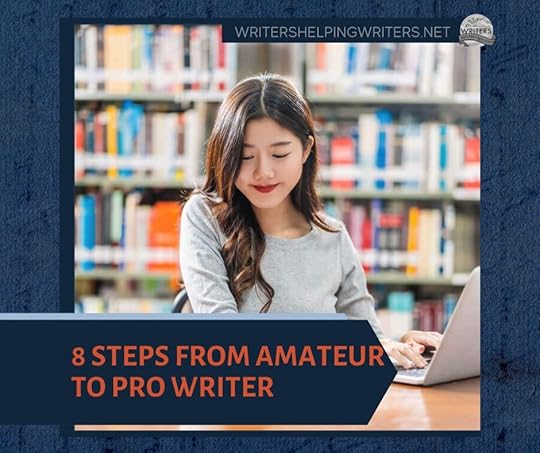
Every author starts out as a hobbyist. We write as kids, for fun. As we get older, we write when we have free time or the fit takes us. For many, that���s as far as it goes, and there���s value in that.
But for others, over time, our writing passion grows. Chances are, if you���re reading this blog, you’re looking to take the next step and become a professional author. Here are 8 changes you should make, in no certain order, to level up your writing to pro status.
1. Make Writing a PriorityThis one is kind of a no-brainer, but it���s hard to do because we have other responsibilities and activities that are important. Paying the bills (working a day job). Parenting. Developing friendships. Bingeing Stranger Things for the third (fourth?) time.
Life is busy, full of non-negotiable duties and fun stuff that steal our time. But the truth is, we make time for what���s important to us.
Pros prioritize writing. This requires a reshuffling of our To Do list. It may mean jettisoning some things completely. Because only when writing is a priority will it get the time and attention needed to take you to the next level.
2. Practice PatienceThe fact that you���re reading this post shows that you recognize the importance of honing your craft and acquiring new skills. Research, learning, application���these all take time.
But once you decide to pursue writing as a career, there���s a natural temptation to escalate the process. After all, this isn���t like other jobs; no one���s monitoring your progress and deciding when you can take the next step. There���s no hierarchical ladder that must be climbed. It���s just you, your computer, and the Publish button.
Patience is a defining characteristic of professionals because they recognize that becoming really good at something doesn’t happen over night. They know that positioning themselves for success takes time. So don���t just focus on the end result of publishing the book or hitting a certain sales milestone. Dedicate yourself to growth and improvement. Respect the journey, and resist the urge to skip steps along the way.
3. Seek Out Criticism (and Be Able to Take It)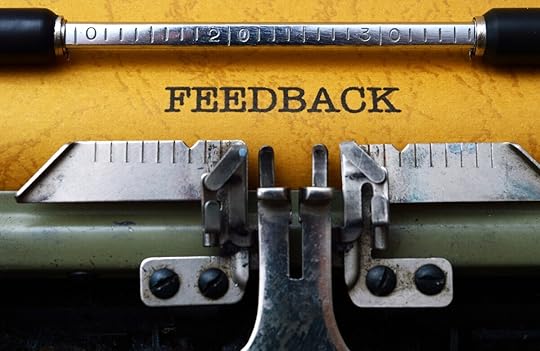
I’ve got an eighth-grade son who loves music. He plays multiple instruments but is focused mostly now on the bass clarinet. Recently, he entered a Solo and Ensemble competition, where students perform a piece of music for a professional adjudicator and are given a grade of Superior, Excellent, Good, etc.
I sat in on his performance and was able to listen to the judge���s feedback. I thought Dominic had done very well, so I was surprised to hear the judge offer so much criticism. I kind of wanted to punch her.
Walking out, I said to D that he���d unfortunately pulled a tough judge, and we would just hope for the best. I got my second surprise of the day when my son said he was happy to have gotten this adjudicator because her helpful feedback was going to make him a better player.
Sure, the score mattered (he got a Superior, by the way), but D recognized that if he wanted to become a premier player, he needed to improve his areas of weakness. And he couldn���t see what those weaknesses were. None of us really can. It takes other people to point them out.
If you want to become better as an author, you have to get helpful feedback. Critique partners and beta readers, writing coaches and editors���there are so many knowledgeable people in the industry who can help with this. But they won’t come to you. To become a superior writer, you���ve got to seek them out and be willing to take their feedback.
4. Become a Perpetual LearnerBecoming a pro takes time because there���s always more to learn. New writing methods and techniques, emerging technologies and software (A.I., anyone?). Marketing, bookkeeping, business strategies . . . Pros know that writing, as a career, is always in flux. If you go into it with the mindset of a lifelong learner, you���ll be able to adjust and won���t get steamrolled when things change.
5. Approach Writing as a BusinessThis is one of the toughest mindset shifts to make because we love the writing so much. We have this image of ourselves as successful authors, sitting in our office typing or scribbling away day after day. And while I would argue that writing is the most important thing, there’s so much more to becoming a pro.
To get there, we have to view writing as a business. Yes, success requires researching and drafting and revising. But it���s also setting up a bank account and ordering checks, filing annual taxes, building a brand, marketing our products, hiring people to do the things we can���t or don���t want to do, creating and maintaining a website, figuring out which distributors to use to sell your books and familiarizing yourself with their platforms���
Oi.
It can be overwhelming because we don���t want to do all that stuff. We. Just. Want. To. Write. Can���t we just write?
Well . . . no. Professional writers do plenty of writing, but they���re also building a business. And all the other stuff is part of that.
This goes back to #4. Broaden your mind and accept this fact: to be a professional, you will have to learn all the things. You don���t have to become an expert; just look at me doing Angela���s and my finances (/shrieks). It���s not easy. It���s definitely not natural, and sometimes it���s not pretty, but I do it because it has to be done. Embrace the lifelong journey of learning these tasks (or learning to outsource them), and you���re on your way to being a pro.
6. Learn to Set (and Meet) Deadlines [image error]Have you heard the (very uplifting) saying that the road to Hell is paved with good intentions? Well, so is the road to becoming a professional author. Intentions won���t get you there. Once we prioritize our writing, we have to set goals. And goals need deadlines because without them, it���s easy to get sidetracked. Setting reasonable timelines for your objectives (and sticking to them) will increase your efficiency and help you get more done in less time.
This tip may seem obvious, because many writers are used to setting goals and deadlines for their writing (1,000 words per day, 3 day per week, complete the first draft in 6 months, etc.). But deadlines can also streamline other parts of the process to keep you on a professional track.
Continuing DevelopmentRead 2 craft books this yearAttend a conference next springTake a course on story structurePlanning a NovelLimit planning and researching to 3 monthsSchedule an interview with XYZ expert before January 10thPublishingQuery 2 agents each week in the month of AugustResearch formatters and hire one (3 weeks total)BusinessSet up a corporation or other business by the end of Q2Find software or a service to track book sales (February)Create a storefront at your site for direct sales (2024)MarketingDraft the back cover copy this weekDecide on a launch event for the next book (summer of 2024)Experiment with Amazon keywords in April and JulyApproach 4 podcasters about being a guest on their show (3 months prior to launch)Setting deadlines for our objectives is crucial. Need help with the goals themselves? We’ve got some posts for you on Writing a Business Plan and Creating a Publication Deadline for Your Next Book.
7. Value Collaboration Over Competition
I don���t know why this is, but we tend to view other people in our space as rivals. We have to be better than them, outdo them, and���Heaven forbid���don���t help them because they’re our competition!
But professional writers realize they don���t corner the market on talent and savvy. The people in their industry who are killing it? Pros want to work with them instead of against them. So pros seek to share knowledge, funnel customers to other writers��� helpful resources, offer to help with someone else���s book launch, promote their course, etc.
Why? Well, because it���s nice to help our fellow humans, and kindness has a pretty good ROI.
But pros also know they have a lot to learn (again, with Point #4���I’m seeing a pattern here). Partnering with the people who have done all the things and are doing them well can shorten their own learning curve. They also know that while they could do the job alone, it���s easier, more efficient, and typically more enjoyable to do it with others.
8. Build ResiliencyLook, those of us who’ve been writing any amount of time know it’s a tough gig. Feedback from critique partners and editors is never what we want it to be. Rejections are more common than acceptances. We get stuck creatively. Other people are writing up a storm or improving by leaps and bounds, and we feel like we���ll never be any good . . .
Sometimes professional writing feels like a middle-school dodgeball game. You’re just getting hammered.
When you get knocked down���by discouragement, industry changes, the jerky internal editor, whatever���keep getting up. Call a writing buddy to commiserate, then get back to work. Take your dog for a walk, then get back to work. Get some coffee, a pink drink, or a jumbo-sized bag of chocolate, then get back to work.
Because even though you haven’t achieved your goals yet, you’re a pro now. And pros are in it for the long haul.
Before You Go. . .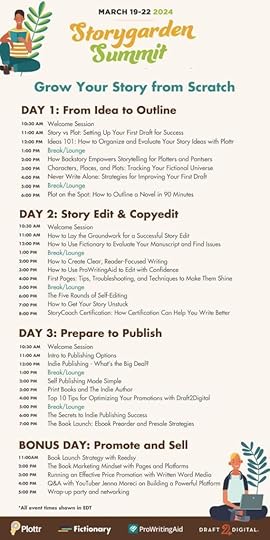
Have you signed up for the Storygarden Summit?
We’re partnering with other industry experts to bring you a garden full of bookish help, taking you through the process of outlining, editing, publishing, and selling.
On Day 2, I’ll take you through a treasure trove of first-page tips so your story’s opening hooks agents, editors, and readers from the get-go!
This summit is very affordable – $5/pay-what-you-can. It runs from March 19th to the 22nd, and you’ll see some top-notch speakers.
Browse the schedule to get an idea of what topics will be covered.
I hope to see you in my First Pages session on March 20th at 4 PM EDT. Hinty-hint, I might have some sweet discounts for our books and One Stop for Writers subscriptions for you!
The post 8 Steps from Amateur to Pro Writer appeared first on WRITERS HELPING WRITERS��.
March 5, 2024
Breathing Life into Characters

Picture a protagonist who stumbles upon a mysterious artifact but shows no curiosity, or a group of friends who sit down separately at the summit of a hike under a breathtaking sunset, without a moment of communal awe.
Keeping your characters engaged with the story keeps readers engaged with it, too. Whenever something significant happens in the story, readers expect the characters to sit up, notice, and process its impact at some level.
The plot���s unfolding impact on the characters lends an organic quality to the storytelling. The characters��� reactions and their attempts to derive meaning from the events around them make the story seem kinetic, vital, living.
This meaning can���t be adequately conveyed by exposition; that would be ���telling,��� not ���showing.��� Instead, giving readers direct access to the context allows them to discover the meaning for themselves. This means exposing your characters��� interpretive process���their emotions, thoughts, and reflections about what’s happening around them.
Read more: 3 action-reaction misfires that flatten your writing
Writing Strategy: The Progress Report
Think of folding character interiority into a passage to create a ���progress report,��� showing the character���s ongoing impressions of what they know and feel so far while the action is still unfolding.
���Simply recognize that there will be a number of sharp twists and small setbacks during the conflict portion of the scene,��� writes Jack M. Bickham in Scene & Structure, ���and your viewpoint character will experience each of these turns as a stimulus; before he replies in most cases you the author have the option going into his brief internalization concerning what was just said or done. It is in these internalizations that you can remind the reader what���s at stake, and how things seem to be going in the opinion of the viewpoint character.���
When it seems time to check in with your viewpoint character���s sense of how things are progressing, ask yourself these questions:
How does the character think things are going so far?Are they closing in on their short-term and long-term goals, or are they losing ground?What���s their mindset when they ponder their goals: anticipation, hope, determination, trepidation, gloom?Building the Stream of PerspectiveProgress checks don���t need to be purely analytical. Action beats also help convey a character���s emotions and show how they���re adapting to what���s unfolding.
Say the boss has just marched into the room with the announcement ���All of that data is out of date.��� You may be tempted to give your poor protagonist an action beat like Jason sighed.
Although that sigh is clich��d and a bit flat���a sigh alone doesn���t tell readers whether Jason is dejected, pissed, or what���your instinct to put a reaction right there is spot on. That���s where readers expect your protagonist���s reaction. That���s where readers want to see how the announcement matters to Jason.
So infuse that action beat with thought to turn it into a statement of intention: As the room exploded with protests, Jason tossed his useless notepad into the trash and groped in the bottom drawer for his whiskey flask. 9:36 p.m.���this was going to be a butt-burner of a night. Now readers know the protagonist���s state of mind: While everyone else is still carping over the problem, Jason���s already bracing himself to correct it. This progress check tells readers what he thinks is important at this point and what he���s planning to do next.
Progress checks like this are the connective tissue that sweeps a story from one point to the next. Keep this burbling stream of perspective turned on throughout every scene.
Opening New AvenuesAt their most effective, progress checks serve as more than mere acknowledgments. They���re often insights of some sort, showing the character���s first glimmer of potential solutions.
Uncovering new consequencesUnderstanding another characterGrasping a problemFathoming the story worldRead more: The link between character thought and credibility
Don���t Wait to React
A major influx of realizations and new information for the viewpoint character often signals that it���s time for a dedicated reflection sequence or scene���but that doesn���t imply you should reserve all emotions, reactions, and thoughts solely for post-action review sessions.
Thought constitutes the most narratively significant part of your viewpoint character���s perspective. It offers readers the sense of an unfolding, real-time experience.
Lengthy passages of dialogue or action without enough interiority leave readers locked outside the character���s frame of reference. When thought is saved exclusively for a post-action analysis, it often comes across more like a narrator���s explanation than spontaneous character experience. Inner life that���s tacked on in flabby lumps after the action or dialogue is over can feel forced.
So stay in touch with the characters��� reactions on every page ���sometimes every paragraph. Keep the spigot of your viewpoint character���s interior analysis flowing. Infuse every page with their opinionated judgments and personal perspective about virtually everything they encounter.
Crafting effective character reactions that move the story forward is an art. Taking the time to unlock your character���s perspective, however, makes the story moving and memorable.
The post Breathing Life into Characters appeared first on WRITERS HELPING WRITERS��.
February 29, 2024
Don���t Make These 10 Self-Publishing Mistakes – Part 2
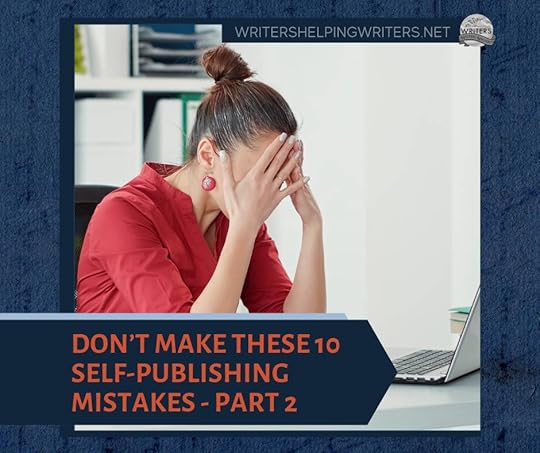
By Sarah Kolb-Williams
In part one, we looked at a few production mistakes new authors can make. Today, we���ll focus on mistakes to avoid while finalizing your files and publishing your book.
6. Skipping the EbookIf you love holding printed books, you might assume your readers feel the same way. But if you���re considering skipping an ebook entirely, think again.
A 2022 report by the Pew Research Center revealed that nearly one in ten readers read exclusively ebooks. That may be just a slice of the pie, but shouldn���t your book be available to everyone?
Publishing a Kindle version of your book with KDP gives you other important benefits:
 You can list your ebook on Kindle Unlimited.With two sets of keywords and categories to work with, you can double your optimization potential (more on that later).Amazon reviews for one format automatically transfer to the other.
You can list your ebook on Kindle Unlimited.With two sets of keywords and categories to work with, you can double your optimization potential (more on that later).Amazon reviews for one format automatically transfer to the other.You���ve worked hard on your manuscript. You���ve gone through multiple rounds of revisions. You���ve had your book designed, edited, and proofread (right?). For most authors, it makes sense to maximize that time, money, and energy by releasing multiple formats.
7. Not Owning Your ISBNsIf you publish through KDP, you have the option to use a free ISBN. But should you?
If you���re only ever planning to publish on Amazon, and if spending $250 for two ISBNs���one each for your print book and ebook���is a financial burden, go ahead and use KDP���s free ISBNs. But understand that other distributors can���t use those ISBNs, and Amazon (not you) will be listed as the publisher on record.
If you later decide to ���publish wide��� with other retailers, you���ll need to create a whole new edition. At the very least, this means a new cover, a new copyright page���and a new ISBN for each format. Suddenly, that ���free��� ISBN has cost you a lot of time, money, and frustration, and you ended up having to buy your own anyway. To keep your distribution options flexible, buy your own ISBNs to begin with.
(Pro tip: If you even suspect that you���ll publish another book or format, grab a block of ten ISBNs from Bowker for $295 right off the bat. Three hundred bucks isn���t nothing, but it���s not much more than the cost of two individual ISBNs, and you���ll be covered for up to eight more formats, editions, or titles.)
8. Failing to OptimizeOptimizing your sales description may sound intimidating, but it���s easier than you might think���and it can mean the difference between online success and total oblivion.
For book listings, optimization comes down to three key elements:
good keywordsgood categoriesgood metadataSo what makes a keyword ���good���? The sweet spot here is finding terms that are appropriate for your book and have a high search volume but a low use volume. In other words, lots of people are using them to search for books like yours, but they aren���t finding much. That���s where your book comes in!
What makes a category ���good���? Same principle: categories that are appropriate for your book, but that don���t have so much competition that you���ll never have a shot at climbing the ranks.
What makes metadata ���good���? This means you���re filling the back end of your book listings with information that accurately describes your book and makes sense to anyone looking for books like yours.
Many authors simply fill in the fields marked ���required��� and leave the rest blank, but that doesn���t help them get discovered. Look for opportunities to add all the useful information you can when you set up your book listings, and you���ll give your book the best shot at being found by your ideal readers.
9. Not Understanding Book Distribution
Here���s the hard truth: with nearly 11,000 books published every day, seeing your book on the shelves of stores like Barnes & Noble just isn���t the reality for most independent authors. Before you decide on a distribution plan, be realistic about your goals.
Even if you can get them interested, most corporate retailers will expect to order your book through standard channels at a wholesale discount of 55%. They���ll also expect the ability to return unsold copies of your book. That discount can seriously cut into your margins, and a mess of unexpected returns can wreak havoc on your accounting.
But think about it: today, many readers shop primarily online for books. For most new authors, the best distribution strategy is meeting those readers right where they are: online. If you���re focused solely on online sales to individual consumers, there���s no reason to set a steep discount or make your book returnable.
The good news is that you can always change your discount and return status later. For now, consider your current goals, and plan your distribution accordingly. Remember, they���re your goals and no one else���s.
(Pro tip: Check that the trim size you���re interested in is compatible with your chosen distribution plan before you start working with a book designer.)
10. Skipping the Post-Publishing TasksPublishing your book might feel like crossing the finish line, but in many ways, the race is only just beginning.
After you celebrate (and turn your computer off for a while and get some well-deserved sleep), here are a few extra steps to consider:
Sign up for Author Central through your KDP account and create your Author Page. (This is also the place to add any editorial endorsements your book has received.)If you haven���t already, set up an author website with a book page, about page, and newsletter sign-up form.Consider ads to increase your sales. Many distribution and social media platforms offer ad packages to increase visibility and encourage readers to buy your book.If you decide to purchase ads, track your numbers carefully to find the right spend amount and ensure the cost of your ads is worth the ROI. (ScribeCount and Publishwide are two low-cost options that can make this task easier.)Don���t stretch yourself too thin on social media. To begin with, focus on the networks you���re most comfortable with, show up consistently, and don���t post only about your book.Sign up for HARO (Help A Reporter Out). Many reporters and bloggers use HARO to find experts to interview about topics they���re writing about. You could be one of them!Try using Google Alerts, Giga Alert, or another web monitoring tool so you know when your name or book title is mentioned.Self-publishing on your own can be intimidating, but it doesn���t need to be. Avoid these mistakes, and you���ll be off to a successful and enjoyable publishing journey that leaves you with the flexibility to control your author career.
Do you have any self-publishing questions?
Sarah Kolb-Williams has been a freelance editor and writer for over fifteen years. She is currently lead editor at Spoonbridge Press, a small publishing services company she cofounded to help independent authors navigate the confusing world of self-publishing. When she���s not working with independent authors, she���s relaxing with her family, enjoying the local live music scene, or tracking down the spiciest food she can find.
The post Don���t Make These 10 Self-Publishing Mistakes – Part 2 appeared first on WRITERS HELPING WRITERS��.
February 26, 2024
Writers, A New Thesaurus Guide Is On The Way!
What’s better than being able to say a new book is coming soon? Sharing that it has close ties to The Emotion Thesaurus, of course!
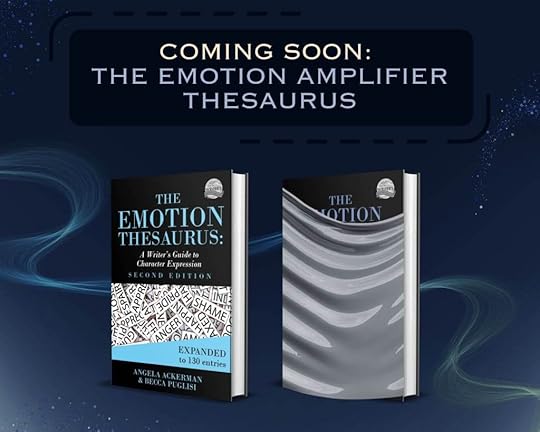
Emotion is HUGE in storytelling, so we’re circling back to bring you The Emotion Amplifier Thesaurus: A Writer’s Guide to Character Stress and Volatility.
If the topic of emotion amplifiers sounds familiar, it may be. Many years ago we created an ebooklet under this name as a companion to The Emotion Thesaurus. It covered 15 states often mistaken for emotions (boredom, stress, hunger, etc.) because they strain a character, making it easier for them to lose control of their emotions.
Did your heartbeat just pick up a little? Because when someone loses control, bad things happen. They lash out, say the one thing they shouldn’t, burn bridges. They act rashly, make mistakes, and create a mess of problems for themselves. Ah, music to a writer’s ears!
But emotion amplifiers do a lot more than destabilize emotions, and there are more than just fifteen, so we knew at some point we would circle back and create a proper guide for you. We can’t wait for you to see it!
We Need Your Help!
Launching a book is a big task and one we need help with. We’re putting together our Street Team and would love for you to share this ride with us!
A Street Team can lend a hand in a variety of ways. They might…Help us build excitement for the book before the releaseShare book graphics, blog posts, and other things we create around the book so writers know this resource is comingRead The Emotion Amplifier Thesaurus and provide an honest review (we have 50 arcs to distribute)Lend us their blog for a day at launch and put up a post written by usUse their social platforms to help us find writers who will find the book helpfulPoint their writing audience to our launch event so they can enter the giveawayBe in our corner and provide help in whatever way they can!The Advantages…If you enjoy being an insider, you’ll get the first look at the cover and have a front row seat to our launch strategy, which can be helpful to you as you release your own book. You’ll see how to communicate with a street team so you can build your own, too. We also give out 50 digital arcs, so you may be one of the first to read and use this guide!
Being part of the Street Team doesn’t mean a mountain of work, either. We try to make it as easy to help as possible. We also respect your inbox. When you sign up, you can let us know what you are interested in helping with, and we’ll make sure you don’t see emails about other things.
Our release date is May 13th. If you think you can spare a bit of time (and your platform) to help, sign up here.
Thank you!The post Writers, A New Thesaurus Guide Is On The Way! appeared first on WRITERS HELPING WRITERS��.
February 24, 2024
Character Type & Trope Thesaurus: Newcomer
In 1959, Carl Jung first popularized the idea of archetypes���”universal images that have existed since the remotest times.” He posited that every person is a blend of these 12 basic personalities. Ever since then, authors have been applying this idea to fictional characters, combining the different archetypes to come up with interesting new versions. The result is a sizable pool of character tropes that we see from one story to another.
Archetypes and tropes are popular storytelling elements because of their familiarity. Upon seeing them, readers know immediately who they’re dealing with and what role the nerd, dark lord, femme fatale, or monster hunter will play. As authors, we need to recognize the commonalities for each trope so we can write them in a recognizable way and create a rudimentary sketch for any character we want to create.
But when it comes to characters, no one wants just a sketch; we want a vibrant and striking cast full of color, depth, and contrast. Diving deeper into character creation is especially important when starting with tropes because the blessing of their familiarity is also a curse; without differentiation, the characters begin to look the same from story to story.
But no more. The Character Type and Trope Thesaurus allows you to outline the foundational elements of each trope while also exploring how to individualize them. In this way, you’ll be able to use historically tried-and-true character types to create a cast for your story that is anything but traditional.

DESCRIPTION: This character is new (in town, at work, to school, etc.) and has to learn the rules for fitting in. The newcomer is frequently used as a narrative device to introduce the reader to the world and explain its various aspects in an organic manner.
FICTIONAL EXAMPLES: Bella Swan (Twilight), Claire Fraser (Outlander), Dorothy Gale (The Wonderful Wizard of Oz), Robert Langdon (The Da Vinci Code), Thomas (The Maze Runner trilogy)
COMMON STRENGTHS: Alert, Cautious, Courteous, Curious, Diplomatic, Independent, Innocent, Introverted, Objective, Observant, Patient, Pensive, Private, Resourceful, Responsible, Sensible
COMMON WEAKNESSES: Apathetic, Childish, Evasive, Gullible, Ignorant, Insecure, Needy, Nervous, Suspicious, Timid, Withdrawn, Worrywart
ASSOCIATED ACTIONS, BEHAVIORS, AND TENDENCIES
Having a fresh perspective
Being curious about their surroundings
Not knowing or understanding the rules of the new environment
Standing back and observing rather than jumping right into things
Adaptability; learning quickly
Noticing everything; being highly observant
Keeping to themselves until they get the lay of the land
Na��vet��
Being an easy target due to their innocence or lack of knowledge
Trying (and failing) to understand the new world through the perspective of their old world
SITUATIONS THAT WILL CHALLENGE THEM
Meeting someone new and not knowing if they’re a friend or foe
Facing hostility and rejection simply because of their outsider status
Being expected to meet certain standards before they’ve developed the skills needed to do so
Getting lost in the new environment
TWIST THIS TROPE WITH A CHARACTER WHO���
Has a hidden agenda for entering the new environment
Has extraordinary skills that are of no use to them in the new world
Is an unreliable narrator who is prone to memory lapses, deception, or selective disclosure of information
Has an atypical trait: Confrontational, Rowdy, Know-It-All, Confident, etc.
CLICH��S TO BE AWARE OF
The intern who must master the skills they’ll need to be successful in the industry
The “chosen one” newcomer who is the only person who can solve the the new world’s problems
Other Type and Trope Thesaurus entries can be found here.
 Need More Descriptive Help?
Need More Descriptive Help?While this thesaurus is still being developed, the rest of our descriptive collection (16 unique thesauri and growing) is accessible through the One Stop for Writers THESAURUS database.
If you like, swing by and check out the video walkthrough for this site, and then give our Free Trial a spin.
The post Character Type & Trope Thesaurus: Newcomer appeared first on WRITERS HELPING WRITERS��.
February 22, 2024
Don���t Make These 10 Self-Publishing Mistakes!

By Sarah Kolb-Williams
I���ve been a freelance book editor for over fifteen years, and I���ve had the privilege of editing hundreds of books. Unfortunately, I���ve seen authors invest serious money only to make publishing mistakes that cost them visibility, sales, and hope.
If you���re self-publishing, you���re wrangling a lot of tasks. After spending so much time on your manuscript, you might feel like you just want to get the thing out there already. But please, fight the urge to skip any of these important steps���any one of them could make or break your chances of success.
In part one of this two-part series, I���ll highlight the biggest book production mistakes I���ve seen new authors make. Next week, I���ll touch on some of the publication mistakes that can tank your chances of succeeding as an independent author.
1. Skipping the RevisionsWriters Helping Writers is full of incredible advice on crafting captivating stories. Even so, when you finally finish that first draft and you���re sick of the sight of it, you might be tempted to jump right in and hire an editor. After all, isn���t it time to start working on your next book?
There���s a lot of advice out there to publish fast, fast, fast. But that���s not the only way to do it. For many reasons, it���s better to focus on quality than speed���especially if this is your first book���and the best way to do that is through diligent author revisions.
So what���s the secret to successful revisions? Time.
While you���re mired in that first draft, you can���t always see what it will be like for a new reader to approach the book. Come back later with fresh eyes, and you���ll be able to recognize where you glossed over key details. You���ll see where your characters aren���t acting characteristically. And you���ll spot leftover debris from moving a section from one spot to another.
Then, after you���ve put your manuscript away for a month or so, it���s time to start your revisions!
2. Skipping the EditingIf you���ve never worked with an editor before, you may be skeptical about what editors can really do for you. It���s your book. Why turn it into somebody else���s?
But a good editor can actually help you sound more like yourself���or at least what you hoped you���d sound like.
A developmental editor can identify holes in your logic and suggest new ways to connect with your audience. A substantive editor can help liven your prose or temper your tone. A copyeditor can ensure that every sentence says exactly what you intended, every mark is pulling its weight, and every word is spelled how it���s supposed to be.
Editors don���t want to take over your manuscript; they want your book to be the best it can be. And isn���t that what your book (and your readers) deserves?
3. Not Prioritizing Book Design
Most authors understand the importance of professional cover design. After all, readers absolutely judge books by their covers, and yours has only a fleeting chance to grab attention. Unfortunately, many new authors treat the interior layout as an afterthought.
You might think that Word document you formatted yourself looks just fine, but readers may think otherwise. Outside of poor editing and lackluster cover design, an amateur interior is one of the biggest ways to lose a reader���s interest.
Here���s just a short list of interior book design principles that new authors often overlook:
Body fonts should be readable, not ���interesting������save those for chapter titles and headings!Text should be fully justifiedWords should be allowed to break at the end of a line (but not across spreads)The last line of a paragraph should not appear alone at the top of a pageBook designers have to juggle all of these design principles and more. Upholding one might mean bending another, and a good designer has the skill and experience to handle these issues appropriately. And, importantly, they know to finesse the spacing of the occasional paragraph or line so they can implement proofreading corrections without creating new issues.
4. Failing to Manage Proofreading
When you���re publishing on your own, you can���t just send your Word document to a proofreader and call it a day. There are more steps involved in proofreading than some authors realize.
Let���s take a look behind the scenes. During proofreading, a publisher might take these steps:
Compare the typeset interior to the copyedited manuscript to ensure no text has gone missingSend to the proofreader to check for text and layout issuesReview changes to ensure nothing will offset the design (and propose light edits as needed to minimize design disruptions)Send changes to the book designer to update the interiorConfirm all updates and check for any new layout issuesSend any corrections back to the book designer as neededPhew!
A traditional publisher or self-publishing company has a whole team of players (or at least a lead editor) to pull it all off. If you���re just one person, review the list above with your proofreader to clarify what they���ll be responsible for, and plan to fill any gaps yourself.
5. Misunderstanding the Purpose of Back Cover CopyThe purpose of that short bit of text on the back of your book is sometimes misunderstood. It isn���t the place to introduce readers to every character. It isn���t a synopsis or a summary. And it definitely isn���t a place to tell readers how the book ends.
In fact, back cover copy (and its online cousin, the sales description���more on that next time!) is an important sales tool. It���s marketing copy, plain and simple, and it should be focused on giving a reader that extra push to pick up your book.
For nonfiction, bullet points help make the copy scannable. Don���t just focus on what your book does; explain how readers will benefit.
For both fiction and nonfiction, start with an opening hook that asks readers a question or piques their interest. Keep it short; between 150 and 200 words is a good goal. And remember, don���t give away the ending!
(Ready to put your back cover copy to the test? Check out ���How to Craft a Top-Notch Blurb.���)
This is by no means a comprehensive list of publishing tasks, but I hope it���s got you thinking about the hidden steps involved in producing a high-quality book. Check back next week for more tips on positioning and distribution that will keep you in the driver���s seat!

Sarah Kolb-Williams has been a freelance editor and writer for over fifteen years. She is currently lead editor at Spoonbridge Press, a small publishing services company she cofounded to help independent authors navigate the confusing world of self-publishing. When she���s not working with independent authors, she���s relaxing with her family, enjoying the local live music scene, or tracking down the spiciest food she can find.
The post Don���t Make These 10 Self-Publishing Mistakes! appeared first on WRITERS HELPING WRITERS��.
February 20, 2024
The Pirate���s Guide to Writing Fantasy
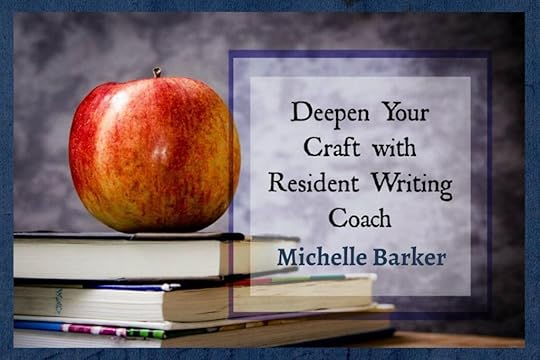
Remember the scene in Pirates of the Caribbean when Captain Barbossa explains the pirate���s code? ���The code is more what you���d call guidelines than actual rules.��� Writing fantasy is a bit like the pirate���s code. There aren���t any rules, exactly, which is what makes it so fun to write. You can allow your imagination free rein.
But there is one ���must have���: strong world-building. And world-building is one of those things that can easily get out of hand.
Guidelines For Avoiding Mayhem
Mayhem may include confusion, infodumping, logic issues, and cliches���all of which impact reader immersion. Here are some ways to keep your fantasy world under control:
Know your world, but don���t overshare: Fantasy writers spend a lot of time on world-building details to make their setting feel authentic. But then they often feel compelled to work all those details into the story, which can lead to info-dumping. Make peace with this truth: you will do more research and world-building than you can realistically fit into your novel. But rest assured, your hard work will pay off: more of it will seep into the setting than you realize. On a similar note���
Keep your readers on a need-to-know basis: Don���t overwhelm us with information. If we don���t need to know something at that moment (or ever), set it aside.
Think carefully before you include a prologue: Prologues are often comprised of a scene relating to the middle of the book that lacks any context. While you might intend yours as an amuse bouche to intrigue us, that lack of context will likely create confusion. But don���t err on the side of info-dumping by including all the things you think we need to know before we can start reading. In fact, we don���t need to know much. Instead���
Throw us into the world but use landmarks so that we���re not lost: Ease us in by including a few familiar things: a horse in the pasture, some daisies in a vase���something we know how to visualize. How you decide to name things becomes a big factor in this process. So���
Name things in such a way that we don���t need a glossary to understand them: If you look at the opening of A Game of Thrones, you���ll notice George R. R. Martin throws us into the story without any preamble, but he calls things by names that have clear meanings: the Wall, the Night���s Watch, the wilding raiders. We don���t need any explanation. We get it.
Too much terminology gets confusing: This includes long words that are capitalized for no reason and have apostrophes in the middle, and unnecessarily weird creatures with unnecessarily weird names. If it has four legs and a tail and it barks, call it a dog.
Play by the rules you���ve made: You can���t suddenly change them just because you���ve put your protagonist in a tight spot.
Remember, there is a world AND there is a story: The world should not be the story. No matter how cool it might be, your world is still just a backdrop for the main event: the characters, what they want, and what���s at stake if they don���t get it.
Honor the rules of logic and cohesion: Again, A Game of Thrones is instructive here. Every region in Martin���s vast world has its own customs and beliefs, its own clothing and food and weaponry. Each choice makes sense according to the climate and geography. Your little microcosm doesn���t have to be based on a real place, but it does have to feel authentic���which means it must make sense.

Keep your magic rules simple: If we need a flow chart to follow it, you���ll lose us. But also remember, magic must come with a cost. If there are no limits, the stakes will be too low, because anyone with magical skill will be able to spell themselves out of a tight spot.
Remember your protagonist���s internal conflict: It���s easy for externals to take over when writing fantasy, but we won���t care about what���s happening or where it���s happening, if we don���t care about who it���s happening to. Our connection as readers is to the protagonist. If you want us to follow them on their quest to achieve a narrative goal, the stakes should be personal. Give us a flawed protagonist who must transform themselves internally in order to succeed.
And speaking of conflict, embrace the grey areas in life: People aren���t generally evil for the sake of being evil, nor do they seek to rule the world just so they can ruin it. On the other hand, no one is one hundred percent good. Nuance is key. Oversimplification of people and situations creates stereotypes and predictable plot turns.
Oh, those tropes: While fantasy readers are looking for an ordinary and unlikely protagonist to rise to the position of hero/heroine, there are lots of ways to make this happen without them having to be orphans or chosen ones or discovering a prophecy that involves them. That���s not to say these things can���t work. They can���but try to make your story unique.
Oh, those characters that sound like someone from Harry Potter or Lord of the Rings: The wise mentor who sound like Gandalf or Dumbledore, the dark lord who resemble Sauron or Voldemort, the dwarves with long beards. Etc. While some of these characters are archetypical, you���ll want to avoid anything that feels derivative.
If you���re aiming to publish traditionally, make sure your first book can stand alone: The market is tough these days and multi-book deals for first-time authors are rare.
In conclusionWriting fantasy gives you an opportunity to do something completely new and different. Is this a tall order? Yes. But that���s what makes it so fun. Even better if you can create a world that tells us something important about ourselves (like Lord of the Rings did with the corrupting nature of power, the strength of fellowship, and the surprising influence of ordinary individuals to make a difference).
That���s the true power of fantasy. By providing readers with an alternate world, you help us see our own with new eyes. And by adhering to the pirate���s code, you can do so without falling prey to the pitfalls that abound in this genre.
The post The Pirate���s Guide to Writing Fantasy appeared first on WRITERS HELPING WRITERS��.
February 17, 2024
Character Type & Trope Thesaurus: Father Figure
In 1959, Carl Jung first popularized the idea of archetypes���”universal images that have existed since the remotest times.” He posited that every person is a blend of these 12 basic personalities. Ever since then, authors have been applying this idea to fictional characters, combining the different archetypes to come up with interesting new versions. The result is a sizable pool of character tropes that we see from one story to another.
Archetypes and tropes are popular storytelling elements because of their familiarity. Upon seeing them, readers know immediately who they’re dealing with and what role the nerd, dark lord, femme fatale, or monster hunter will play. As authors, we need to recognize the commonalities for each trope so we can write them in a recognizable way and create a rudimentary sketch for any character we want to create.
But when it comes to characters, no one wants just a sketch; we want a vibrant and striking cast full of color, depth, and contrast. Diving deeper into character creation is especially important when starting with tropes because the blessing of their familiarity is also a curse; without differentiation, the characters begin to look the same from story to story.
But no more. The Character Type and Trope Thesaurus allows you to outline the foundational elements of each trope while also exploring how to individualize them. In this way, you’ll be able to use historically tried-and-true character types to create a cast for your story that is anything but traditional.
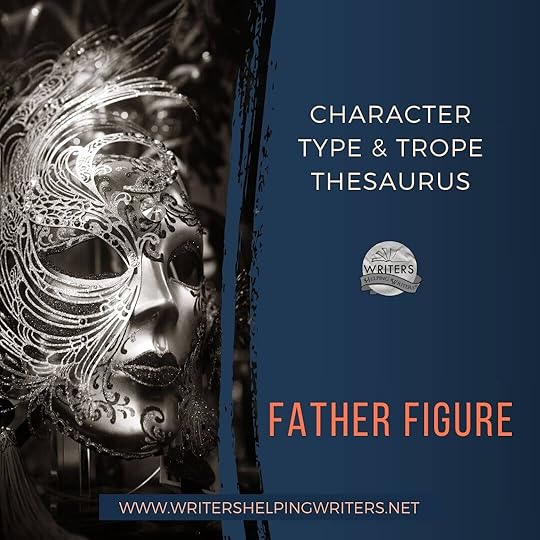
DESCRIPTION: This character plays the role of a protective, attentive, nurturing, and wise caregiver to the protagonist. Though the father figure often has no children of his own (or he’s estranged from them), this isn’t always the case.
FICTIONAL EXAMPLES: Mr. Murry (A Wrinkle in Time), Albus Dumbledore (the Harry Potter series), Alfred Pennyworth (the Batman franchise, Uncle Iroh (Avatar: The Last Airbender), Obi-Wan Kenobi (Star Wars: A New Hope)
COMMON STRENGTHS: Confident, Empathetic, Friendly, Generous, Honorable, Industrious, Inspirational, Intelligent, Kind, Loyal, Nurturing, Perceptive, Persuasive, Protective, Responsible, Sensible, Supportive, Unselfish, Wise
COMMON WEAKNESSES: Controlling, Grumpy, Impatient, Know-It-All, Manipulative, Nosy, Obsessive, Pushy
ASSOCIATED ACTIONS, BEHAVIORS, AND TENDENCIES
Being protective of their charge
Sharing their wisdom
Taking or creating opportunities to teach
Being supportive of the people in their care
Being authoritative when necessary
Making sacrifices for the people in their care
Offering guidance to others
Manipulating circumstances (when necessary) to work out the way they think they should
Focusing too much on one charge and neglecting the others
Forgetting, at times, that the protagonist isn’t their child, and taking the fatherly role too far
SITUATIONS THAT WILL CHALLENGE THEM
Being unable to both protect the protagonist and do what’s best for the greater good
A physical or social limitation preventing the father figure from being a reliable protector and mentor
Watching the protagonist go their own way and reap the consequences of poor choices
TWIST THIS TROPE WITH A CHARACTER WHO���
Is deeply flawed
Teaches the protagonist to question authority and rebel against societal norms
Is absent in the story but is influencing their protagonist through their example and the advice they once gave
Has an atypical trait: Spoiled, Prejudiced, Hypocritical, Forgetful, Cynical, etc.
CLICH��S TO BE AWARE OF
The father figure whose infallibility and seeming omniscience render them unrelatable
The afterthought parent who only shows up at key plot points to provide guidance
Other Type and Trope Thesaurus entries can be found here.
 Need More Descriptive Help?
Need More Descriptive Help?While this thesaurus is still being developed, the rest of our descriptive collection (16 unique thesauri and growing) is accessible through the One Stop for Writers THESAURUS database.
If you like, swing by and check out the video walkthrough for this site, and then give our Free Trial a spin.
The post Character Type & Trope Thesaurus: Father Figure appeared first on WRITERS HELPING WRITERS��.
February 14, 2024
Phenomenal First Pages Contest

Hey, wonderful
writerly people!
It���s time for Phenomenal First Pages, our monthly critique contest. So, if you need a bit of help with your first page, today’s the day to enter for a chance to win professional feedback!
Entering is easy. All you need to do is leave your contact information on this entry form (or click the graphic below). If you are a winner, we’ll notify you and explain how to send us your first page.
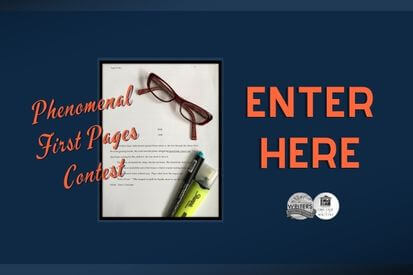 Contest DetailsThis is a 24-hour contest, so enter ASAP.Make sure your contact information on the
entry form
is correct. Three winners will be drawn. We will email you if you win and let you know how to submit your first page. Please have your first page ready in case your name is selected. Format it with 1-inch margins, double-spaced, and 12pt Times New Roman font. All genres are welcome except erotica.Sign Up for Notifications!
Contest DetailsThis is a 24-hour contest, so enter ASAP.Make sure your contact information on the
entry form
is correct. Three winners will be drawn. We will email you if you win and let you know how to submit your first page. Please have your first page ready in case your name is selected. Format it with 1-inch margins, double-spaced, and 12pt Times New Roman font. All genres are welcome except erotica.Sign Up for Notifications!If you���d like to be notified about our monthly Phenomenal First Pages contest, subscribe to blog notifications in this sidebar.
Good luck, everyone. We can’t wait to see who wins!
PS: To amp up your first page, grab our First Pages checklist from One Stop for Writers. For more help with story opening elements, visit this Mother Lode of First Page Resources.
The post Phenomenal First Pages Contest appeared first on WRITERS HELPING WRITERS��.
Writers Helping Writers
- Angela Ackerman's profile
- 1022 followers



